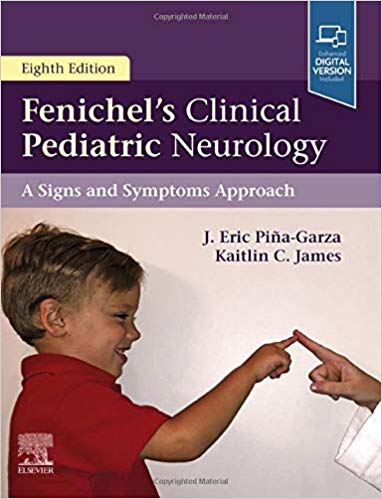Fenichel’s Clinical Pediatric Neurology (2019) is principally for pediatricians and neurologists, but there are very good reasons why generalists should have a good look at this book as well: it’s well organized in its clinical approach and will help you learn how to solve clinical problems in other fields too.
Take, for example, hexosaminidase A deficiency (Tay-Sachs disease), a prototypical inherited metabolic disease. Most medical students learn about Tay-Sachs disease in the context of other inherited metabolic diseases, particularly Gaucher disease, Fabry disease and Niemann-Pick disease, the lysosomal storage diseases.
This pathophysiology-driven classification scheme can be somewhat useful clinically as well. You see, the lysosomal storage diseases tend to have important clinical features in common. In particular, they tend to cause slowly progressive neurological, developmental and psychiatric problems, with or without involvement of the mononuclear phagocyte system (e.g., hepatosplenomegaly). In contrast, patients with phenylketonuria or urea cycle defects, or other “small molecule” inherited metabolic diseases, tend to exhibit rapid cognitive decline without serious dysmorphic features.
While this classification scheme is useful to those who are first learning about diseases whose etiologies are known, it doesn’t work very well in clinical situations where the challenge is to distinguish among diseases that are similar in terms of clinical presentation but are very different from a pathophysiological standpoint.

For example, a child might present with a more generic neurological problem, say, progressive proximal weakness. Your clinical challenge would be to figure out whether the diagnosis is juvenile-onset Tay-Sachs disease, or perhaps something different altogether, say spinal muscular atrophy. This can be a lot trickier because you need to be able to distinguish Tay-Sachs disease from any number of clinical mimics, many of which bear little pathophysiologic resemblance to Tay-Sachs disease. Therefore, knowing that Tay-Sachs disease is pathophysiologically similar to Gaucher or some other previously-mentioned lysosomal storage disease is of no help here.
So sticking with the Tay-Sachs example, Clinical Pediatric Neurology (2019) tells you how to work this all out. The differential diagnosis for progressive proximal weakness in juveniles includes both Tay-Sachs disease as well as spinal muscular atrophy. To distinguish between the two one must look closely for signs and symptoms of cerebral involvement (e.g., intellectual decline). Cerebral involvement points more to Tay-Sachs disease and is classically absent in patients with later-onset spinal muscular atrophy. (See, id. at 178). This added level of analysis can only be gotten from a clinician or from a clinical textbook. It cannot be gotten from a preclinical genetics or biochemistry text because these publications are not organized in a way that allows for these distinctions to be made and emphasized.
Unfortunately and somewhat paradoxically, the book has persistent organizational issues. Continuing with the example noted above, Tay-Sachs disease is discussed more fully on page 131, but it is also discussed on page 178, without cross-references in the original discussion and without any mention in the index of the added discussion. The book needs more extensive internal cross referencing as well as an index upgrade. I hope that these issues will be resolved in future editions.
Still, there are plenty of reasons to love this book, and I therefore recommend Fenichel’s Clinical Pediatric Neurology (2019) very highly to neurologists, pediatricians, emergency physicians, and family medicine practitioners, as well as residents in these fields. Ambitious third and fourth year medical students, as well as practitioners in other fields, should consider having a close look at this book as well.


Leave a Reply